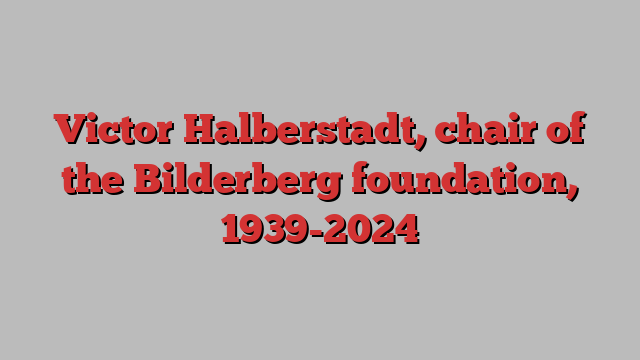
Unlock the Editor’s Digest for free
Roula Khalaf, Editor of the FT, selects her favourite stories in this weekly newsletter.
Victor Halberstadt spent his early years in hiding. He was born to a Jewish family in Amsterdam in 1939. The following year, Nazi Germany invaded the Netherlands.
Throughout the war, Halberstadt was hidden by a family of Dutch farmers in the countryside. Unlike Anne Frank, he was neither discovered nor betrayed and so survived the war.
Later in life, Halberstadt, who has died at the age of 85, became chair of the Bilderberg foundation, which organises a high-powered annual meeting of political, business and security leaders from Europe and North America. His deep commitment to the transatlantic relationship was shaped by his wartime experiences.
One of his earliest memories was emerging from hiding to see the American troops who had just driven the Nazis out. He later discovered that Henry Kissinger, who became a close friend, had been stationed nearby with the US army. As Halberstadt explained: “Without the generous American rescue of Europe, I might not have survived.”
Bilderberg is dedicated, above all, to keeping the US and Europe working together, in the defence of democracy. The annual meeting is a unique forum because of its small size and the influence of some of its participants. The 120 people at the Bilderberg gathering in Washington in 2022 included the US national security adviser, the director of the CIA, the secretary-general of Nato, two European prime ministers and the chief executives of Pfizer, OpenAI, Palantir, BP and TotalEnergies. Kissinger, who was on the group’s steering committee for decades, was attending his 45th Bilderberg meeting.
A professor of economics at Leiden University in the Netherlands, Halberstadt was first invited to attend Bilderberg in 1975. Other first-timers at that meeting included Margaret Thatcher and Donald Rumsfeld. Halberstadt later recalled entering the dining room on the opening evening and being beckoned over by his fellow countryman, Joseph Luns, who was then secretary-general of Nato. Denis Healey, Britain’s chancellor of the exchequer, was also at the table. Luns invited Thatcher to join them — but she had veered away at the last moment because, as she later explained to Halberstadt, she regarded Healey as a communist.
Halberstadt’s own political views were on the centre-left. He was a long-standing member of the Dutch Labour party. His gregarious nature, discretion and political antennae meant that he was swiftly invited into the leadership group of Bilderberg, helping to steer its annual meetings for more than 40 years.
Although he was an academic, Halberstadt felt perfectly at ease on the Bilderberg steering committee, rubbing shoulders with business potentates such as David Rockefeller and Giovanni Agnelli. Many members of the group became confidants and dinner guests at his apartment overlooking the Amstel river in Amsterdam, which was decorated with paintings by his second wife, the artist Masha Trebukova.
Bilderberg meetings often feature in conspiracy theories. Fidel Castro accused the group of plotting to install “a world government that knows no borders”. The same accusation is often made by far-right American figures, such as Alex Jones. But Halberstadt was scornful of such theories. He liked to point out that the meetings, the guest list and topics to be discussed at Bilderberg are all made public. The contents of the discussions, however, are kept private to allow for a frank exchange.
Thrashing out differences and tensions between American and European leaders — and between liberals and conservatives — has been the central aim of the group ever since the first meeting was convened at the Bilderberg hotel in the Netherlands in 1954. Over the decades, the conferences have provided a forum for sometimes heated debates on all the controversial geopolitical issues of the day — from the 1956 Suez crisis to the wars in Vietnam and Iraq. Halberstadt, though, always resisted the idea that Bilderberg’s membership should become global. In his view there was a special quality and importance to the transatlantic relationship that needed to be nurtured.
Halberstadt also sat on the advisory boards of Goldman Sachs and Daimler-Benz. But the outside commitment that probably meant most to him was his service on the board of the International Centre for Missing and Exploited Children.
He attended his last Bilderberg meeting in Madrid in May of this year. His death marks the passing of a generation whose commitment to the transatlantic relationship was profound, personal and rooted in the experience of the second world war.